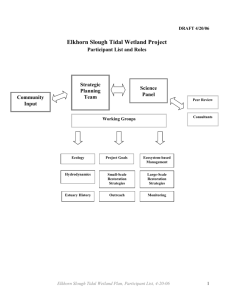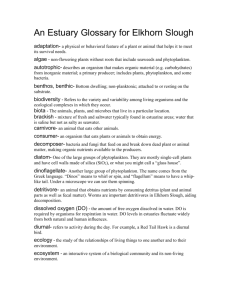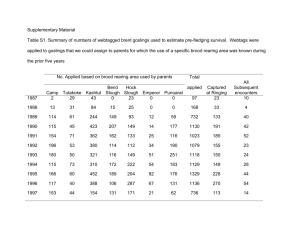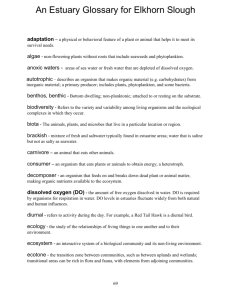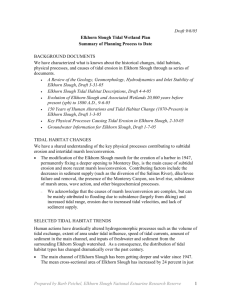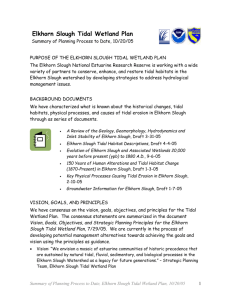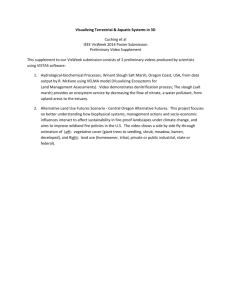Objective 1 - Elkhorn Slough Foundation
advertisement
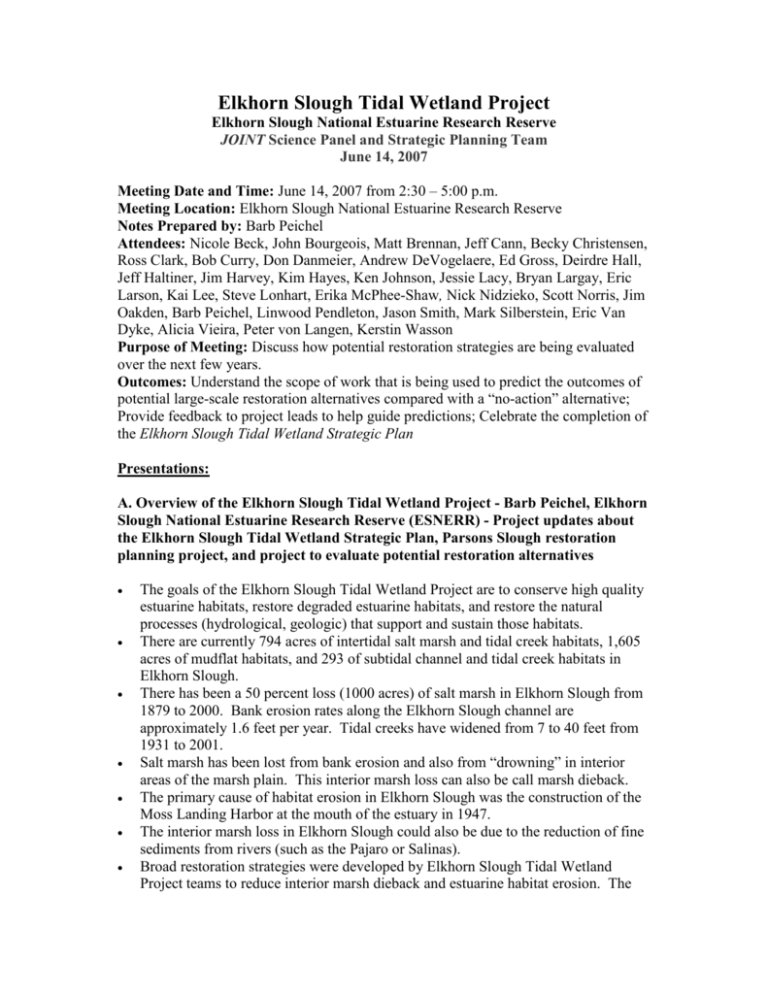
Elkhorn Slough Tidal Wetland Project Elkhorn Slough National Estuarine Research Reserve JOINT Science Panel and Strategic Planning Team June 14, 2007 Meeting Date and Time: June 14, 2007 from 2:30 – 5:00 p.m. Meeting Location: Elkhorn Slough National Estuarine Research Reserve Notes Prepared by: Barb Peichel Attendees: Nicole Beck, John Bourgeois, Matt Brennan, Jeff Cann, Becky Christensen, Ross Clark, Bob Curry, Don Danmeier, Andrew DeVogelaere, Ed Gross, Deirdre Hall, Jeff Haltiner, Jim Harvey, Kim Hayes, Ken Johnson, Jessie Lacy, Bryan Largay, Eric Larson, Kai Lee, Steve Lonhart, Erika McPhee-Shaw, Nick Nidzieko, Scott Norris, Jim Oakden, Barb Peichel, Linwood Pendleton, Jason Smith, Mark Silberstein, Eric Van Dyke, Alicia Vieira, Peter von Langen, Kerstin Wasson Purpose of Meeting: Discuss how potential restoration strategies are being evaluated over the next few years. Outcomes: Understand the scope of work that is being used to predict the outcomes of potential large-scale restoration alternatives compared with a “no-action” alternative; Provide feedback to project leads to help guide predictions; Celebrate the completion of the Elkhorn Slough Tidal Wetland Strategic Plan Presentations: A. Overview of the Elkhorn Slough Tidal Wetland Project - Barb Peichel, Elkhorn Slough National Estuarine Research Reserve (ESNERR) - Project updates about the Elkhorn Slough Tidal Wetland Strategic Plan, Parsons Slough restoration planning project, and project to evaluate potential restoration alternatives The goals of the Elkhorn Slough Tidal Wetland Project are to conserve high quality estuarine habitats, restore degraded estuarine habitats, and restore the natural processes (hydrological, geologic) that support and sustain those habitats. There are currently 794 acres of intertidal salt marsh and tidal creek habitats, 1,605 acres of mudflat habitats, and 293 of subtidal channel and tidal creek habitats in Elkhorn Slough. There has been a 50 percent loss (1000 acres) of salt marsh in Elkhorn Slough from 1879 to 2000. Bank erosion rates along the Elkhorn Slough channel are approximately 1.6 feet per year. Tidal creeks have widened from 7 to 40 feet from 1931 to 2001. Salt marsh has been lost from bank erosion and also from “drowning” in interior areas of the marsh plain. This interior marsh loss can also be call marsh dieback. The primary cause of habitat erosion in Elkhorn Slough was the construction of the Moss Landing Harbor at the mouth of the estuary in 1947. The interior marsh loss in Elkhorn Slough could also be due to the reduction of fine sediments from rivers (such as the Pajaro or Salinas). Broad restoration strategies were developed by Elkhorn Slough Tidal Wetland Project teams to reduce interior marsh dieback and estuarine habitat erosion. The restoration alternatives propose to change the estuary’s entrance to reduce the tidal influence and habitat erosion and restore or add sediment to promote marsh growth. Information about these potential restoration options are discussed in Chapter 4 of the Elkhorn Slough Tidal Wetland Strategic Plan (http://www.elkhornslough.org/tidalwetland/strategic_plan.htm). In order to make a decision about whether to pursue a large-scale restoration project for Elkhorn Slough, technical evaluations need to be conducted. The Tidal Wetland Project initiated a project in early 2006 to use an ecosystembased management approach to evaluate potential Elkhorn Slough restoration strategies compared with a “no-action” alternative with support from The David and Lucile Packard Foundation and Resources Legacy Fund Foundation. The evaluations of different restoration strategies include predictions about changes to water quality conditions, species composition, socioeconomics, and the rate of marsh loss and habitat erosion. In addition, an analysis of political constraints and project costs will be conducted. The partners for these efforts include the Elkhorn Slough National Estuarine Research Reserve, Elkhorn Slough Foundation, Monterey Bay Aquarium Research Institute, and The Ocean Foundation who will work with the Elkhorn Slough Tidal Wetland Project teams and the consulting firm, Philip Williams and Associates, Ltd. The leads will be presenting during today’s meeting. The main outcome of the ecosystem-based management project will be a decision about whether to pursue large-scale restoration to reduce habitat erosion and marsh loss in Elkhorn Slough. More information can be found at http://www.elkhornslough.org/tidalwetland/ebm.htm. The Tidal Wetland Project (TWP) also obtained funding from the U.S. Environmental Protection Agency and the Coastal Conservancy to develop a Parsons Slough Wetland Restoration Plan. The schedule includes developing project goals (7/2007), a quality assurance project plan (8/2007), an existing conditions report (12/2007), sediment additions report (4/2008), and a restoration alternatives report (5/2008). The TWP Strategic Planning Team and Science Panel will provide a review of these draft documents. The Parson Restoration Team includes representatives from the U.S. Environmental Protection Agency, Coastal Conservancy, Coastal Commission, Elkhorn Slough National Estuarine Research Reserve, U.S. Geological Survey, Regional Water Quality Control Board, U.S. Fish and Wildlife Service, Moss Landing Marine Laboratories, and CA Department of Fish and Game. The Consulting Team includes Moffatt & Nichol, Chambers Group, Inc., FarWest Restoration Engineering, and Wetlands and Water Resources. More information can be found at http://www.elkhornslough.org/tidalwetland/parsons.htm. I will hand out Elkhorn Slough Tidal Wetland Strategic Plans after the presentations. Thank you all for all your input and work to conserve and restore Elkhorn Slough. 2 B. Evaluation of Tidal Hydraulics and Geomorphic Change under different Restoration Alternatives: A Progress Report – Don Danmeier, Phil Williams & Associates - Preliminary restoration alternatives under consideration, progress on hydrodynamic modeling, and discussion of projecting geomorphic change. The literature review of case studies of projects to inform Elkhorn Slough restoration planning is posted on the website at http://www.elkhornslough.org/tidalwetland/downloads/LitReview.pdf. The case studies included sites in Louisiana, Jamaica Bay (New York), and U.K. marshes in southeast England. Each case study covers site descriptions, causes of wetland losses, and management actions. The main findings were that: o The main approaches are to manage marsh hydrology, place dredge material on degraded marsh sites, divert river flows to deliver sediment to marshes, and spray dredging material on degraded marshes. o Sediment placement has achieved short-term success, but it’s often difficult to achieve target elevations, managed marsh hydrology often diminishes sediment accumulation, and long-term sustainability requires addressing the sediment budget. The restoration strategies to reduce interior marsh loss and estuarine habitat erosion that were developed by the Tidal Wetland Project are being evaluated compared with a no-action alternative. They include alternative 1 (no action), alternative 2 (new ocean inlet), alternative 3 (highway 1 sill), and alternative 4 (Parsons Slough restoration). The restoration alternatives propose to change the estuary’s entrance to reduce the tidal influence and habitat erosion and restore or add sediment to promote marsh growth. A hydrodynamic model has been developed and calibrated for the Elkhorn Slough estuary. The model output will include estimates of tidal prism, tidal asymmetry, tidal inundation characteristics. The next steps will be to run the model for the no action alternative for 0, 10, and 50 years. Following that, the model will be used to predict hydrodynamic, geomorphic, and habitat changes for each restoration alternative which will be done during this fall. Q&A Why weren’t more case studies done on habitat erosion instead of marsh dieback? There are very few examples of habitat erosion but both Louisiana and Jamaica Bay have problems from dredging and straightening of channels (in LA from oil and gas development). How will you predict sea level rise with the model? We will incorporate it for the 10 and 50 year scenarios but have to understand those predictions in combination with sediment demand. What specific tidal range are you shooting for new inlet? We plan to do a preharbor modeling run to get an idea of what the tidal range was like for that. We will also look at the inundation and tidal prism curves for other California estuaries. Are you looking at restoring sediment sources (e.g. Salinas and/or Pajaro Rivers)? Yes, we will be looking into that in a broad way. s 3 C. Interaction of Oxygen and Nutrient Dynamics with Hydrology – Ken Johnson, Monterey Bay Aquarium Research Institute (MBARI) - Modeling efforts that can be used to predict biogeochemical properties of different restoration options. We are monitoring water quality in Elkhorn Slough through the LOBO chemical sensor network (http://www.mbari.org/lobo/). Showed a slide of 1 year of nitrate in Elkhorn Slough. As you can see, nitrate levels range from 0 to 300 micromolar (or 0 to 4 parts per million) for this the site near seal bend in Elkhorn Slough. These levels are much higher that the goals for Chesapeake Bay. External sources of nitrates appear on the incoming tides. The annual nitrate transport measured by our water quality equipment in the Old Salinas River channel exceeds the combined annual transport of the San Lorenzo, Pajaro, Salinas, and Carmel Rivers combined. We now have four years of nitrogen data. Jane Caffrey described these as world record nitrate levels. We now have 1.5 years of ammonium data, but it is not on web yet. The largest sources look like they are on low tides and are internal and from the sediment sources (carbon) and may be there many years. Internal and external nutrient sources make loading difficult to control. Our first management action should be to reduce the high inputs of nutrients to Elkhorn Slough. As part of the ecosystem-based management project, I am running a simple box model with 15 grid points to predict water quality changes with different restoration scenarios. In some areas, there are already hypoxic events right now in Elkhorn Slough. I picked the month of July which are the most severe levels of low dissolved oxygen. Reducing the tidal exchange in Elkhorn Slough can decrease the dissolved oxygen levels. So the water quality conditions constrain restoration options unless external nutrient sources are first dealt with. Joe Needoba who has served on the Tidal Wetland Project Team will be leaving us for a faculty position out of state this fall. Q&A Would a sill near the estuarine mouth make water conditions better or worse? Actually, most of the nutrient-laden freshwater from the Old Salinas River is less dense so it more of it would probably come into Elkhorn Slough. Wouldn’t alternative 2 (new ocean inlet) pretty much shut off the high external sources of nutrients to Elkhorn Slough? Yes. What do you mean that residence time reduced mixing time and will make ammonia concentrations go higher? It doesn’t make sense with primary productivity - even if we tripled ammonium or nitrate it doesn’t seem it would make much of a difference since the system is already super-saturated. But more nitrate would allow more carbon to build up. A higher residence time makes water warmer so you also don’t have as much mixing and less light penetration. We already know that the lower part of Elkhorn Slough is well mixed, but not in upper slough and yet phytoplankton abundance is not 4 higher in upper slough. We could look at lower Moro Cojo Slough because it gets choked with algae during the summer. D. Interactions of Wetland Elevation, Hydrology, and Sediment on Marsh Habitats – Eric Van Dyke, ESNERR - Measuring wetland elevations, water level, and sediment distribution through tide level monitoring and sediment elevation tables. My role in the ecosystem-based management project is to monitor water levels and sediment processes over time and try to understand how they affect marsh loss. A couple of centimeters make a whole world of difference to these marsh plants. To understand the relative elevation changes, first there has to be a vertical control which is done through a continuous GPS station, deep-rod benchmarks, differential leveling, height modernization, and elevation surveys (optical/laser). To track deep subsidence and/or tectonic events here at the Reserve, we have a high quality GPS. This GPS station is continuous so it can help resolve centimeter-level uncertainties. I uncovered and resurveyed some old land-based elevation benchmarks (installed in the 1970s) and we also added additional ones. This summer we are working with the National Geodetic Survey to measure elevations using height modernization technology. This past month NOAA worked with us to install two tide stations in Elkhorn Slough, one at Yampah Marsh and one at Kirby Park. The one at Kirby Park will be there for one year and the one at Yampah Marsh will be moved every few months to a new tidal creek location. What we hope all of this will tell us is what the inundation of the tides is on the marsh and find out the duration to see if there are increases over time and understand if long residence times of water standing on the marshes is causing the plants to die. The purpose of these stations is to provide measurements of tide levels that could help explain changes we’ve seen in the Slough, most notably marsh dieback. You can view the data from the Elkhorn Slough tide stations by going to http://tidesandcurrents.noaa.gov/station_retrieve.shtml?type=Tide+Data. To find data from Yampah Marsh, go to 9413631 Elkhorn Slough at Elkhorn, CA. To find data from Kirby Park, go to 9413651 Kirby Park, Elkhorn Slough, CA. If marshes are healthy, they accrete sediments to keep pace with rising water levels (e.g. sea-level rise). If marshes are sick, the plants die and they lose their elevation. Marshes can build their elevations through both organic (plant material) and/or inorganic (river sediment) sources. We have also installed and are monitoring Sediment Elevation Tables (SETs) in Elkhorn Slough’s marshes. These help us tease apart the marsh sediment question. We also put in feldspar markers which will help us understand and shallow subsidence. Q&A It looks like you will get an accurate understanding for existing conditions, but what have you done to compare that with historic conditions for Elkhorn Slough? The quick answer is not much yet. The old vertical datums are quite 5 different and most surveyors used older benchmarks but these weren’t tied together so there could be large errors. I did fine some FWS data recently that might be helpful in these comparisons. What sort of vertical accuracy do you have from the LIDAR? They are advertising between 10-15 cm vertical for elevations, but have been accurate locally around 10 cm. There seems to be a lot of subtle differences in marsh elevations throughout Elkhorn Slough – are the new benchmarks in marshes? No. E. Predicting Responses of Key Species to Restoration Alternative – Kerstin Wasson, ESNERR - Predictions based on a synthesis of published literature, Elkhorn data, and expert opinion on habitat requirements and factors that limit distribution and abundance of selected estuarine organisms The biological predictions of the ecosystem-based management project will be to assess the distribution and abundance of key species under different largescale restoration alternatives. Species were selected by both ecological criteria (e.g. altering habitat structure, providing food resources) and socioeconomic criteria (e.g. popular with the public, harvested locally, or commercial value). There are many species that meet these criteria but had to select just a few to focus on. Key groups are eelgrass, pickleweed, oysters, large clams, flatfish, and shorebirds. The process will be a literature review of habitat requirements and factors that drive distribution and abundance, expert review of that report, and synthesis of Elkhorn Slough data and trends. Then, we will use the physical predictions from the other groups modeling to make the biological predictions. Eelgrass was chosen because it provides habitat for many species, including commercially viable flatfish, acts as an “ecosystem engineer” trapping sediment and slowing water velocity, and has declined dramatically on the Pacific Coast. The key habitat requirement from the literature review is slow-moving water that is clear enough to allow light to penetrate. Pickleweed was chosen because it supports estuarine food webs through detritus, traps sediments and slows water velocities, takes up nutrients and can improve water quality, and has declined dramatically in Elkhorn Slough over the past 150 years and on the entire Pacific Coast. Oysters were chosen because they serve as an “ecosystem engineer” by providing reef structure, have declined dramatically on the Pacific Coast, and competes with many non-native species in Elkhorn slough. Oysters were extremely abundant in Elkhorn Slough in the early 1990s but currently appear to have a very limited distribution and low recruitment rates. Large clams (gaper, Washington, littleneck, jackknife clams) and benthic invertebrates (fat innkeeper worms and ghost shrimp) were chosen because there are harvested by humans as food and bait and are a key food resource for flatfish, sharks and rays, and sea otters. Most of these species are absent or rare behind water control structures such as tide gates. 6 Shorebirds (willets, godwits, curlews, and sandpipers) were chosen because they rely on estuaries as migratory stopovers and important to bird watchers. The aerial extent of mudflats with appropriate invertebrate food resources is important for shorebirds. Flatfish were chosen because estuaries provide an important nursery function and they are a lucrative commercial fishery offshore. Eelgrass provides important refuges for these species. The end result of this work will be qualitative statements describing if how the abundance and distribution of these species might change from existing conditions. We will probably see tradeoffs of different abundances of species under different restoration alternatives. Q&A How important is marsh for shorebirds - it seems that some roost in marsh areas through Elkhorn Slough? There might be alternative habitats for them nearby so managers will have to look at the regional scope. I’m not sure I understand your statement of “this species doesn’t do well behind water control structures” – we need to really tease these out since the large-scale restoration alternatives suggested differ a lot from tide gates in existing muted areas of Elkhorn. I don’t think our predicted conditions will correspond with any existing areas of Elkhorn Slough. F. Linking Estimates of Economic Value and Analyses of Legal and Policy variables to decisions to restore Elkhorn Slough – Judy Kildow, MBARI & Linwood Pendleton, The Ocean Foundation - Provide estimates of economic values (consumptive and non-consumptive uses) that could result from restoration options; possible links between Slough and local economy changes; legal and regulatory framework affecting implementation; and politics of implementing projects based on case studies of comparable efforts (lessons learned). When was the last time an important decision was being made and you anticipated that a certain outcome would happen, but something else happened instead? You probably assumed that the decisions were being made solely on facts and information. As part of the ecosystem-based management project, we are trying to understand why people make their decisions. Sometimes pieces of information are missing or the information is there but people don’t use them (maybe other issues took precedence and politics played a role). linking policy and economics – economics is bridge between policy and management Some of the information needs we are addressing are a jurisdictional framework for the estuary, understanding major users and interests, and relevant policy issues. We are conducting case histories of estuary restoration projects in the west coast to learn from their experiences. We selected cases based on criteria such as the 7 estuary size, location, population, similar restoration issues, the cost of restoration, jurisdictions, and similarity of economic activities. Policy work will create a framework of jurisdictions, regulations, politics of users, and project complexity. Economics evaluation will look at human uses and values (indicators) economic impacts from changes in ecosystem assets and services in Elkhorn Slough. We are trying to value the impact on people of different restoration alternatives. There are market-based (e.g. Moss Landing Harbor) & non-market based (e.g. birdwatchers) stakeholders. We know very little about economic values except for commercial fishing so we are just focusing on indicators. Some examples of indicators are harbor dredging (volume) and kayaking (# visits/expenditures). Currently we don’t know exactly how many people use Elkhorn Slough and why. For example, there are 264,000 visits to the Moss Landing state beach each year and if people spend about $25 per beach visit (locally), then we can value beach visits in the millions. We have also plotted some data that compares flatfish species commercial catches compared with annual hypoxic (low oxygen) water quality events so we know that they are an estuary-dependent species. when plotting data out – flatfish are important We will be doing similar socioeconomic indicator work in Morro Bay and San Monica Bay too. We are also conducting a one-year user survey for anyone that uses Elkhorn Slough. Please participate in the Elkhorn Slough user survey at http://www.surveymonkey.com/s.aspx?sm=jgE3ErRJvfJlHajxudSYTA_3d_3d. Your responses will help to determine how visitors are supporting the local economy and how the proposed restoration alternatives in Elkhorn Slough will change human recreation in the area. Q&A How are you valuing the scientific community – we are all spending millions of dollars locally? It is important, but the bottom line is that you would probably study Elkhorn Slough whether it was a degraded or restored system. What happens when the economic data is in direct conflict with the most sound ecological restoration option? Having the economic data will help you in your decision-making because fisherman and kayakers are part of the system too but is important to know how significant the tradeoffs might be. The socioeconomic analysis will bring data to the table that hasn’t been there before so we will have a new understanding of Elkhorn Slough. The socioeconomics are so closely linked with the ecology usually, that it should drive us in the right direction, but we have to understand the politics too. 8
